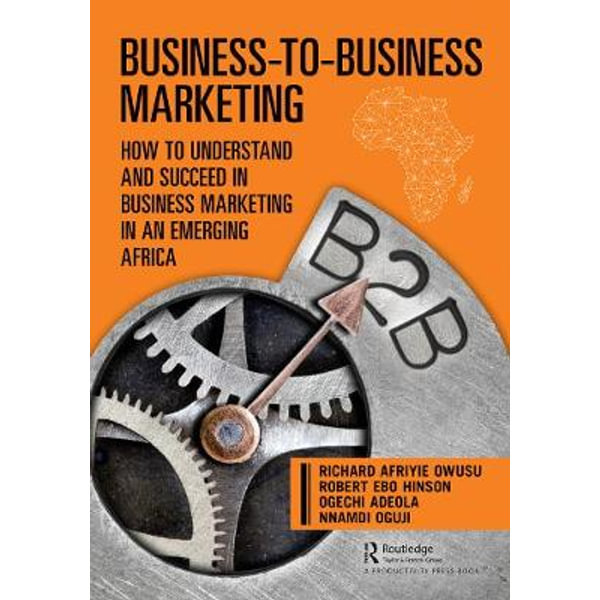Description
How to Understand and Succeed in Business Marketing in an Emerging Africa
Business-to-Business Marketing: An African Perspective: How to Understand and Succeed in Business Marketing in an Emerging Africa is a comprehensive application of the most current research results, concepts and frameworks to the African business-to-business (B-to-B) context. The chapters are designed to provide the reader with a thorough analysis of b-to-b. Important aspects like competitive strategy in B-to-B, marketing mix strategies, relationship management and collaboration, business services, big data analysis, and emerging issues in B-to-B are discussed with African examples and cases. As a result, the book is easy to read and pedagogical. It is suitable for courses at universities and other tertiary levels, undergraduate and graduate courses, MBA and professional B-to-B marketing programmes. Working managers will find it a useful reference for practical insights and as a useful resource to develop and implement successful strategies.
Table of Contents
INTRODUCTION TO THE BOOK
Introduction and Learning Objectives
What is Marketing?
How is marketing done?
Conclusion
References
Part 1: Characteristics of the business-to-business market
Chapter 1: The business-to-business market
1.1. What is business-to-business marketing?
1.1.1. What are the key components of business-to-business marketing?
1.1.2. Marketing mix factors in business-to-business marketing *
1.1.3. The marketing philosophies/concepts in the business-to-business marketing context
1.2. Parties in the business-to-business market
1.3. Functions or Types of business-to-business Producers
1.4. Similarities and differences between business marketing and consumer marketing
1.5 Conclusion
References *
1.7. Case Study: Crispy Kreme of South Africa: A b-to-b or b-to-c company?
1.8. Insights into some African business markets: Kenya, South Africa, Tanzania, and Ghana.
1.8.1. Kenya’s b-to-b market – Examining the tourism sector
References
1.8.2. The Motor Industry Development Programme in South Africa.
References
1.8.3. Evolution of the Tanzanian innovation ecosystem
Conclusion
References
1.8.4. Business Relationships in an Enterprise Cluster of Informal Artisans in Ghana
References
Chapter 2: Strategy in the business-to-business market
2.1. Strategy for the business-to-business market
2.2. Formulating Strategy in B-to-B
2.3. Strategy in Micro, Small and Medium-sized Enterprises; and Entrepreneurial Companies
2.4. Contents of Business-to-business Strategy
2.5. Segmentation, Targeting and Positioning (STP) in B-to-B
2.6. Modes of Collaboration and Competition in Business-to-Business Markets
2.7. Conclusion
References
2.8. Case and Exercise: Unitrans – getting your food to the dining table
Part 2: Marketing and Purchasing in the Business-to-business Market
CHAPTER 3:THE MARKETING MIX IN THE BUSINESS-TO-BUSINESS MARKET
Murphy, D. (2007, April 6). B-TO-B vs B2C Marketing – Similar but Different. Retrieved from https://masterful-marketing.com/marketing-B-to-B-vs-b2c/
CHAPTER 4: SELLING TO BUSINESS BUYERS
4.1. B-TO-B Buyers
4.2. Participants in the B-TO-B buying decision-making
4.3. B-TO-B buying situations
4.4. Modes of B-TO-B Buying
4.5. B-TO-B buying decision-making process
4.6. Determinants of B-TO-B buying behaviour
4.7. B-TO-B Buying Techniques
4.8. B-TO-B selling strategies
Customer‐oriented selling strategy
4.9. Conclusion
References
4.10. CASE AND EXERCISE
CHAPTER 5: BUYING FROM BUSINESS SELLERS
5.1. Nature of business-to-business (B-TO-B) selling
5.2. B-TO-B Sellers
5.3. Principles of B-TO-B selling
5.4. B-TO-B selling process
5.5. B-TO-B Selling Techniques
5.6. Conclusion
5.7. CASE STUDY: THE GREAT GHANA BANK (GGB)
Part 3: Competitive Aspects of the Business-to-business Market
CHAPTER 6: BUSINESS-TO-BUSINESS SERVICE DELIVERY
6.1. B-TO-B Service concept
6.2. B-TO-B service industry
6.3. Characteristics of B-TO-B services
6.4. B-TO-B service quality models
6.5. The relevance of B-TO-B service quality improvement
6.6. Case Study: Delighting the b-to-b service recipient – the value of the basics.
CHAPTER 7: BUSINESS-TO-BUSINESS SOURCING AND OUTSOURCING
7.1. Why source and outsource?
7.2. The Scope of Sourcing
7.3. The future of global outsourcing
7.4. Why do businesses outsource?
7.5. Why has Africa not succeeded in becoming an outsourcing hub?
7.5. Conclusion
7.6. Case Study
Chapter 8: Systems and Project Business
8.1. What are Systems and Project Business?
8.1.1. Systems Business
8.1.2. Project Business
8.2. The nature and role of relationships and networks in systems and project business
8.3. B-to-B Opportunities for Suppliers, sub-Contractors, Consultants, and Financiers
8.4. The Project Business Process
8.5. The relationship between project management and project business
8.6. Risks and project business strategy
8.7. Success factors for systems and project business in Africa
8.8 Conclusion
8.9. Case and Exercise
References (Main Text)
References (Case)
Chapter 9: Managing Business with Governments, Institutions, and Non-business actors
9.1. What are Institutions?
9.1.1. Roles of Institutions in the African business-to-business market
9.1.2. Non-profit / idealistic / administrative / social objectives
9.1.3. How should b-to-b companies manage the idealistic/administrative/social objectives of Institutions?
9.1.4. Marketing and management interactions and relationships with institutions
9.1.5. How should b-to-b companies manage marketing and management interactions and relationships with institutions?
9.2. International Institutions and non-Business Actors in African Business-to-business Markets
9.3. Non-governmental organisations (NGOs)
9.3.1. Non-profit / Idealistic objectives
9.3.2. How should b-to-b companies manage the idealistic component of non-governmental organisations?
9.3.3. Marketing and management interactions and activities of non-governmental organisations
9.3.4. How should b-to-b companies manage the marketing and management interactions and relationships with non-governmental organisations?
9.4. Conclusion
9.5. Case and Exercise: How to improve public purchasing and save money for the government? The case of Ghana’s National Procurement Policy.
CONCLUSION
References (Chapter)
References (Case)
Part 4: Strategic Alliances and Collaborative Relationships Management in the
10.2 Partner Selection for Joint Ventures and Partial Acquisitions
10.3 Key Success factors for Joint Ventures and Partial Acquisition
Chapter 11: Buyer-Seller Relationship in Business-to-business (B-to-B) Marketing in the
11.1. Introduction
11.2. Understanding the Business to Business Market
11.3 Types and Importance of Alliances in the Business-to-Business (B-to-B) Market
11.4 Importance of b-to-b relationships
11.5. The Role of Decision Makers in B-to-B Context.
11.6. How to develop different types of a valuable business relationship
11.7. Initiating and Influencing Buyer-Seller Relationship in Business-to-Business Markets
11.8. Performance of Non-Equity Alliance in Africa
11.9. Communication methods in business relationships
11.11 Conclusion
Case and Exercise
12.1. Introduction
12.2. Brand Positioning Strategies
12.3. Harnessing social media and internet platforms for brand and customer loyalty
12.5. Customer Relationship Management (CRM): A tool for building customer loyalty
Part 5: Capacity Development in the African Business-to-business Context
Chapter 13: Developing Sales and Marketing Capability in African B-TO-B Context
13.1. Developing a Sales Organisation and a Sales Process
13.2. Developing a Strategic Sales Organization
13.3. Developing a Sales Organisation and a Sales Process
13.4. KAM Business Case
13.2. Developing a Sales Process
13.3. Engaging the Key Account Personnel
CASE STUDY
Part 6: Emerging Issues in Business-to-business Marketing
Chapter 14: Emerging Issues in Business-to-Business Marketing
14.1. The impact of globalisation on B-TO-B and how companies are responding
14.2. Transitioning to Servitization and Servitization strategies in business-to-business
14.3. How Digitalization and Artificial Intelligence are transforming business-to-business marketing
CONCLUSION






